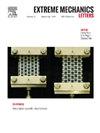Mechanical performance of reconfigurable origami structures fabricated by cutting and planar assembly
IF 4.5
3区 工程技术
Q2 MATERIALS SCIENCE, MULTIDISCIPLINARY
引用次数: 0
Abstract
Origami structures with reconfigurable properties typically exhibit multifunctionality due to their diverse shape transformations. However, such structures often incorporate non-Euclidean vertices, rendering them non-developable and incapable of being flattened, and thus typically necessitate 3D printing for fabrication. In this study, a method of planar cutting and folding followed by assembly has been developed. The planar cut origami structure(PCOS), fabricated using this method, consists of non-Euclidean origami units that undergo transitions between mountain and valley folds during the folding process, granting the structure a high degree of reconfigurability. Through shape reconfiguration, the structure can achieve various self-locking and non-self-locking configurations. Compression tests in the Z-direction were conducted on multiple configurations, both self-locking and non-self-locking. The results demonstrate a significant difference in Z-direction compressive performance between the two types. When all units are self-locked, the peak stress reaches 139 kPa, representing an approximate 267 times increase compared to the non-self-locking configuration. Additionally, the mechanical performance is directly influenced by the number and distribution of self-locking units. By adjusting the self-locking units and their distribution, the peak stress of the model can be tuned to several gradient ranges, including 100 kPa, 101 kPa, 2 × 101 kPa, 3 × 101 kPa, and 102 kPa. This reconfiguration of mechanical properties, driven by geometric transformations, allows the planar cut origami structure to perform different functions depending on the environment, demonstrating significant potential for practical engineering applications.
可重构折纸结构切割与平面装配的力学性能
具有可重构属性的折纸结构通常由于其不同的形状转换而表现出多功能性。然而,这样的结构通常包含非欧几里得顶点,使它们不可显影且无法被扁平,因此通常需要3D打印来制造。在本研究中,提出了一种平面切割、折叠、装配的方法。使用这种方法制作的平面切割折纸结构(PCOS)由非欧几里得折纸单元组成,这些折纸单元在折叠过程中经历了山折和谷折之间的转换,从而赋予了结构高度的可重构性。通过形状重构,结构可以实现各种自锁和非自锁配置。在自锁和非自锁两种配置下进行z向压缩试验。结果表明,两种类型在z向压缩性能上存在显著差异。当所有单元都自锁时,峰值应力达到139 kPa,与非自锁配置相比增加了大约267倍。此外,自锁单元的数量和分布直接影响其力学性能。通过调整自锁单元及其分布,可以将模型的峰值应力调整到100 kPa、101 kPa、2 × 101 kPa、3 × 101 kPa和102 kPa的梯度范围内。这种由几何变换驱动的机械性能的重新配置,允许平面切割折纸结构根据环境执行不同的功能,显示出实际工程应用的巨大潜力。
本文章由计算机程序翻译,如有差异,请以英文原文为准。
求助全文
约1分钟内获得全文
求助全文
来源期刊

Extreme Mechanics Letters
Engineering-Mechanics of Materials
CiteScore
9.20
自引率
4.30%
发文量
179
审稿时长
45 days
期刊介绍:
Extreme Mechanics Letters (EML) enables rapid communication of research that highlights the role of mechanics in multi-disciplinary areas across materials science, physics, chemistry, biology, medicine and engineering. Emphasis is on the impact, depth and originality of new concepts, methods and observations at the forefront of applied sciences.
 求助内容:
求助内容: 应助结果提醒方式:
应助结果提醒方式:


